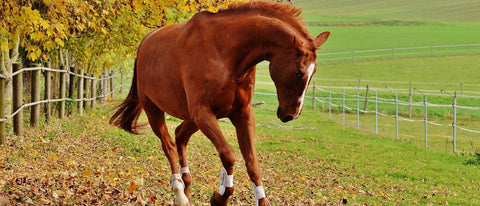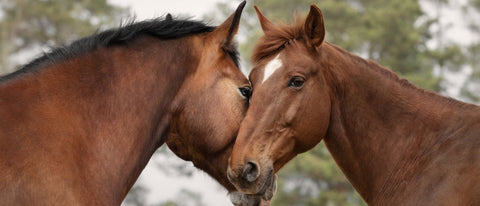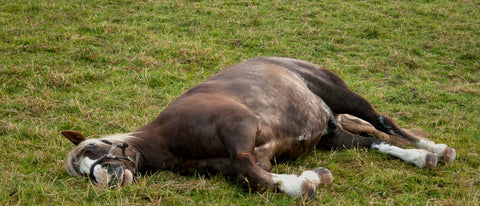
Florian ist aufgewachsen auf einem Bauernhof. Umgeben von Pferden, entdeckte er früh seine Faszination für diese majestätischen Tiere. Inspiriert von seiner reitbegeisterten Mutter, entwickelte er das Nahrungsergänzungmittel - Pferdegold. Seine tiefe Verbundenheit zur Natur und die leidenschaftliche Hingabe zu Pferden trieben ihn an, sein Unternehmen zu gründen.
The term shivering or shivering syndrome already indicates that this is a tremor.
It is derived from the English term "to shiver," meaning "to tremble." Shivering is also colloquially referred to as the trembling disease.
At first glance, horses suffering from shivering may appear healthy.
Shivering in horses is a neuromuscular disorder in which muscle spasms lead to cramps in the hindquarters.
Visually, these spasms manifest as tremors, which can vary in intensity depending on the stage of the disease. In severe cases, the forelegs and head may also be affected.
In this guide, you will learn what causes shivering in horses, what symptoms you can recognize, and how you can help your beloved pet.

Shivering: What does shivering mean in horses?
If the horse is shaking, it may be due to muscle spasms caused by a malfunction .
In various situations, cramps of varying severity may occur, which may look like tremors.
Shivering in horses occurs most frequently in animals between the ages of four and seven.
Larger breeds, such as warmbloods with a height of 1.75 meters or more, or coldbloods, are often affected. The disease is more common in geldings and stallions than in mares.
The disease has been known since the 19th century. The horse trembles uncontrollably, for example, when scraping its hooves or backing up .
It often jerks up one hind leg and remains in this position before putting the leg down again.
Shivering is often confused with houndstooth, which is a separate neuromotor disorder .
It can also be confused with kissing spines , a serious and incurable disease of the spine .
Most often, the horse's hindquarters tremble. Depending on the stage of the disease , the entire body may tremble. This also affects the shoulder muscles, elbows, neck, and head .
In some animals, ears or eyelids also tremble.
Although horse shivering cannot be cured , experts believe that horses do not experience any discomfort or pain other than muscle cramps.
The disease progresses slowly with increasing age.
All causes at a glance
Shivering in horses has long been known and researched, but a specific cause has not yet been identified. When a horse trembles, several causes come into consideration :
- Genetic causes
- Neurological causes
- Neurological problems during embryonic development
- Various traumas
- Diseases of the mare during pregnancy
The cause of shivering in horses can be incomplete impulse transmission from the central nervous system via the neurons to the muscle cells.
This results in uncontrolled muscle twitching. Why the information from the central nervous system is incompletely transmitted is unknown.
According to a study, impaired muscle metabolism could be the cause of horse tremors. The horses participating in this study had significantly lower glycogen levels in their muscle cells than healthy animals. Because glycogen stores deplete more quickly, muscle loss and underweight can occur.
One muscular metabolic disorder in horses is PSSM , a disease that hasn't been recognized for very long. This condition may contribute to the development of shivering .
Another study assumes that when a horse trembles, the cause is a deterioration of neurons in the cerebellum , which leads to uncontrolled impulse transmission .
During shivering, the nerve conduction activity doesn't function as it should. Tension and movement work well, but relaxation after movement is limited.
Shivering can become more severe under stress. Stress leads to increased muscle cramps.

First signs & typical symptoms: How to recognize shivering!
To help your beloved pet early on, you should be familiar with the symptoms of shivering in horses . Affected horses usually behave inconspicuously in everyday life. The trembling doesn't occur constantly.
Shivering syndrome can be recognized in horses by various movement patterns, such as backing up. Depending on the progression of the disease, muscle tremors can be more or less severe. The horse cannot control these muscle tremors independently.
Various behaviors and symptoms indicate shivering:
- Horse jerks its hind legs upwards and puts them down again when the muscle cramp has subsided
-
Muscle cramps increase when the horse stands still for a long time
- If the horse stands on three legs for a long time, for example when cleaning its hooves, the muscle cramps become stronger
-
Noticeable tail beating
- Twitching or crooked tail
- Weak hindquarters
- High muscle tone
- General poor performance
- Horse stretches its front legs completely and does not lift them loosely and bent
Shivering in horses manifests itself as muscle tremors. When shivering occurs in horses, the symptoms initially appear in the hindquarters. As the disease progresses, muscle tremors may occur in the shoulder. The horse's entire body will tremble if the disease is already advanced. Also pay attention to your horse's head.
Shivering involves twitching the ears and eyelids .
All symptoms of shivering are aggravated in stressful situations.
If your pet is under stress, you can most easily observe the signs.

Perfect for your horse: Pferdegold® supplementary feed!
These specially developed supplements support your horse's diet and provide it with natural nutrients. Made in Germany, grain-free and drug-free, they come with a 30-day money-back guarantee.
Try it now!Risks: What consequences can shivering have in horses?
The causes, as well as the risks and consequences, of shivering are not precisely known. The disease progresses more or less severely with age . The disease is incurable.
According to experts, shivering itself is not painful for the horse. However, the muscle spasms often lead to blockages and severe tension, which can be extremely uncomfortable for your horse. In the later stages of the disease, muscle loss and weight loss are to be expected. Performance declines significantly.
Treatment: What can you do?
With the right treatment, you can't cure shivering, but you can counteract the problems that arise in the form of muscle cramps. To be on the safe side, you can consult your veterinarian, who can perform a blood test to diagnose the problem. Based on the concentration of various minerals, such as
- Magnesium,
- Manganese,
- Zinc,
- Selenium and
- copper
The veterinarian will get an indication as to whether your horse is affected by shivering.
The veterinarian may also examine the liver, as it plays an important role in metabolism.
In addition to feeding your horse correctly, various other measures are suitable for treatment:
-
Sufficient space: To avoid cramping when backing up and making tight turns, your horse needs sufficient space. An open stable is ideal.
Long periods of standing should be avoided, as this could worsen symptoms. Cold and wet conditions can cause discomfort and should be avoided.
-
Training: Horses with shivering can be ridden. When training your horse, you should pay attention to muscle development and maintenance, especially in the back area.
How frequently and intensively you can train your horse depends on the progression of the disease. Groundwork, lunging, and gymnastics are all suitable. This training supports muscle metabolism.
-
Avoid stress: Shivering symptoms can worsen under stress. Identify situations that stress your horse and avoid them.
A visit to the farrier, for example, can be stressful. If possible, you should avoid having your horse shod. If shod is necessary, it's a good idea to warm up the muscles.
-
Health management: To relieve tension and blockages, regular treatments with an osteopath or equine physiotherapist are beneficial. A physiotherapist can help your horse with massages. Therapy blankets, such as massage or acupressure blankets, are easy to use in everyday life.

Feeding horses with shivering syndrome: What should you pay attention to?
Proper feeding contributes significantly to the well-being of a horse with shivering syndrome. Therefore, make sure to provide high-quality feed.
Roughage that is free of germs, mold, and dust is best. Hay has a lower acid content than haylage and is therefore more suitable.
You should avoid silage because of its high acid content. Silage and other highly acidic feeds can place unnecessary strain on the liver and disrupt liver metabolism, which negatively impacts muscle metabolism.
Since your horse needs vitamins and minerals, you should have your veterinarian check his blood values regularly to determine how his supply is.
Horses with shivering often have low manganese levels, which is why manganese is an important mineral for the horse .
Conclusion
Shivering in horses is a neuromuscular disorder characterized by muscle cramps. These cramps are visually noticeable as tremors, especially in the hindquarters.
The causes of the disease have not yet been researched.
Shivering is incurable and progresses with age. The condition isn't painful for the animal, but the muscle spasms and tension can be uncomfortable for the horse . With sufficient space, targeted training, and high-quality feed, you can significantly improve your horse's quality of life.
IMPORTANT:
Pferdegold is not a substitute for veterinary diagnosis or treatment . The information contained in this article is for general informational purposes only and is intended to help improve your horse's well-being.
Pferdegold products do not treat or cure diseases , but rather support your horse in correcting nutritional deficiencies through targeted nutrient intake. However, they are not a substitute for professional advice from a veterinarian or specialist.
If your horse has any health problems , we strongly recommend consulting a veterinarian . Pferdegold assumes no liability for decisions made based on the information provided here.
FAQ
Is shivering in horses curable?
Shivering in horses is incurable. The condition progresses to a greater or lesser extent with age. With the right treatment, you can improve your horse's quality of life and counteract muscle spasms.
Can you ride a horse with shivering?
You can ride a shivering horse, as exercise is important for maintaining muscle tone. Some horses with shivering even compete in competitions. How much strain you can place on your horse depends on the progression of the condition.
Is shivering painful?
Experts believe that shivering is not painful. However, muscle cramps and tension can be unpleasant.
🐎 Learn more about horse health and read the next guides!

















